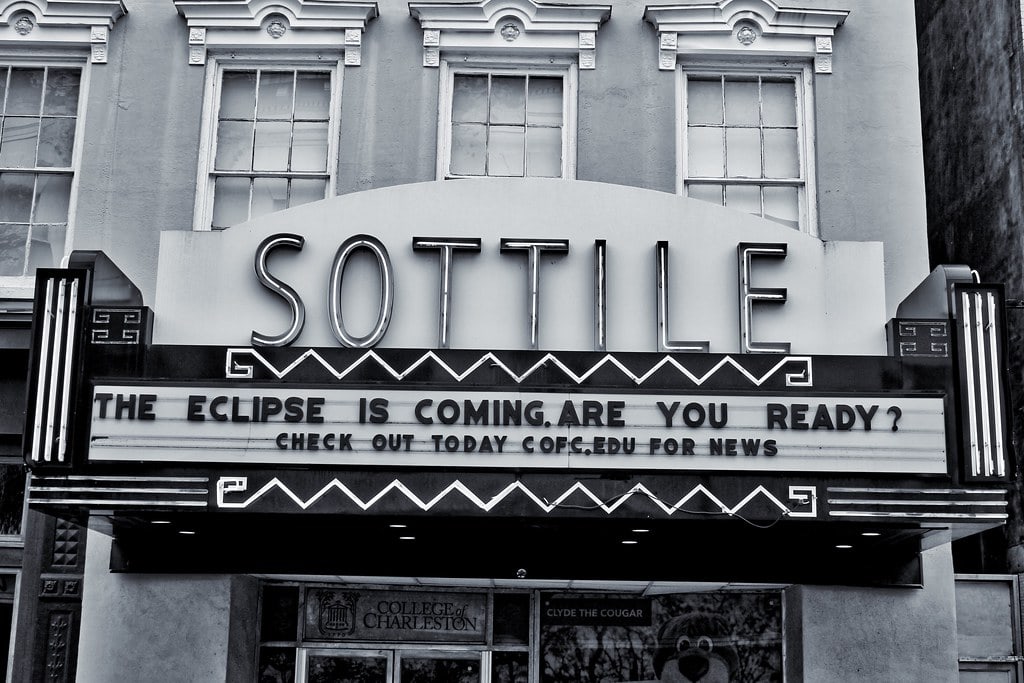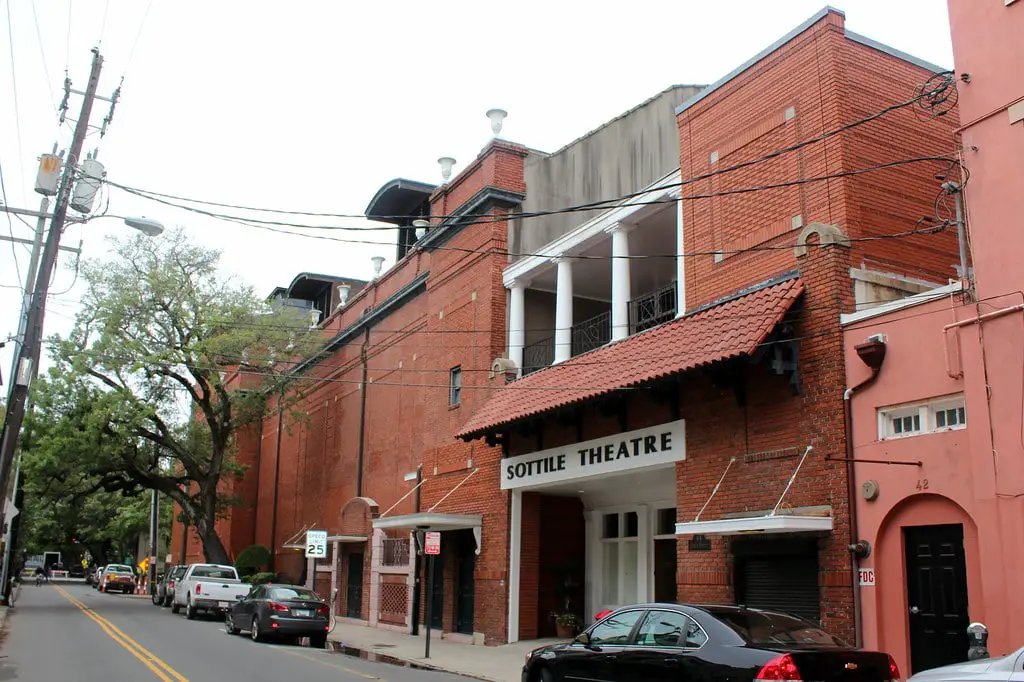The Grand Opening and Early Years
Charleston’s cultural landscape changed forever on a balmy evening in August 1927. The Gloria Theater, later known as the Sottile Theatre, opened its doors, ushering in an era of entertainment and grandeur previously unseen in South Carolina.
Built by Albert Sottile and his Pastime Amusement Company, the venue was a testament to the roaring twenties’ extravagance and a beacon of the arts in Charleston.
The theater, designed by the renowned architect C.K. Howell, who had already left his mark with Charleston’s Garden Theater in 1918, was a marvel of its time. With a seating capacity of nearly 2,000, it was the largest theater in the state, dwarfing its contemporaries in size and splendor.
The Gloria was not just a theater; it was an experience, a place where the citizens of Charleston could escape into a world of vaudeville, touring shows, and silent films.
The opening night featured Norma Shearer’s “After Midnight,” a silent film that captivated audiences with its drama and elegance. This event marked the beginning of the theater’s storied history as a cornerstone of Charleston’s cultural scene.
The Sottile Theatre became a place where memories were made, families and friends gathered to be entertained, and the arts flourished.
As the years passed, the theater adapted to its audience’s changing tastes. From vaudeville to silent films and eventually to “talkies,” the Sottile Theatre remained at the forefront of Charleston’s entertainment scene. It was more than just a venue; it was a cultural institution where the arts were celebrated and cherished.
In the heart of Charleston, the Sottile Theatre stood as a testament to the city’s love for the arts and its commitment to providing a space where creativity could thrive. It was a place where one could step out of the ordinary and into the extraordinary, a cornerstone of things to do in Charleston, SC.
The theater’s early years set the stage for decades of performances, events, and memories, securing its place in the history of Charleston and the hearts of its residents.
Architectural Splendor and Artistic Details
The Sottile Theatre, originally the Gloria Theater, is a monument to 1920s elegance and design. Architect C.K. Howell, known for his work across the Southeast, including the Empire and Lyric Theaters in Richmond, Virginia, brought a slice of grandeur to Charleston.
The theater’s design, with its ornate decorations and luxurious interiors, mirrored the opulence of the era.
Inside, the theater was a feast for the eyes. Italian artists, hired for their exceptional skills, adorned the walls with murals that depicted scenes of centaurs and nymphs set against lush, imaginary landscapes.
These artworks, classical in their themes, were crafted directly onto canvas, adding a touch of European elegance to the heart of Charleston.
Charles A. Hottinger, a New York-based artist known for his work in the Capitol Theater in Lancaster, Pennsylvania, was responsible for the ornamental and decorative painting that completed the theater’s lavish interior.
Its innovative lighting and design features further enhanced the theater’s ambiance. A shimmering blue dome, studded with lights to mimic a starry sky, crowned the auditorium, creating an atmosphere of outdoor serenity.
The side archways, covered with intricate ironwork, and the plush, gold, and buff color scheme added layers of sophistication and comfort, making every visit an unforgettable experience.

The Golden Age of Cinema and Decline
The Sottile Theatre’s transformation into a movie palace coincided with the golden age of cinema. The 1930s and 1940s saw the theater packed with eager moviegoers, drawn by Hollywood’s allure and the silver screen’s magic.
The South Carolina premiere of “Gone with the Wind” in the late 1930s was a landmark event, attracting film enthusiasts from across the state and cementing the theater’s place in Charleston’s cultural history.
However, the post-war era brought challenges. The 1950s saw a decline in attendance, and a trend mirrored nationwide as television became the new focal point of entertainment.
Despite a brief resurgence in the 1960s, sparked by the popularity of “The Sound of Music,” the theater could not sustain its former glory. The once-thriving movie palace began to see fewer and fewer visitors, a shadow of its bustling past.
The final curtain fell in the mid-1970s when the theater closed its doors, succumbing to the changing tides of entertainment and urban development.
The grandeur that had defined the Sottile Theatre appeared to be a relic of the past, a memory of Charleston’s golden age of cinema and live performance.
But this was not the end. The theater’s story was set to continue, taking on a new role in a city that cherished its history and looked forward to its future.

A New Era: College of Charleston’s Acquisition
In 1975, the once lively Sottile Theatre closed its doors, marking the end of an era. However, the story didn’t end there.
The College of Charleston saw potential in the aging structure and purchased it a year later, in 1976. Initially, the college used the theatre for storage, a far cry from its glamorous past. Yet, this period was just a brief intermission in the building’s history.
The late 1980s brought a wave of change. The College of Charleston, under the leadership of President Dr. Harry M. Lightsey Jr., embarked on a mission to breathe new life into the theatre.
By 1990, after extensive renovations, the theatre reopened its doors, not just as a storage space but as a vibrant performing arts venue. This significant shift began a new chapter in the theatre’s history.
The renaming of the theatre to honor Albert Sottile, a nod to its founder and a gesture of respect to the Sottile family’s contributions to Charleston, solidified the venue’s new identity.
As it was now known, the Sottile Theatre became a hub for college performances and community events and a symbol of the city’s ongoing cultural renaissance.
Restoration and Discovery
The turn of the century brought further changes to the Sottile Theatre. In 2011, during routine improvements, a remarkable discovery was made.
Hidden beneath layers of acoustic tiles were two large-scale murals painted directly onto the walls during the theatre’s original construction in the 1920s.
These artworks, depicting scenes of classical mythology, were the work of Italian artists brought over specifically for this purpose.

The discovery of the murals sparked a new restoration project aimed at preserving these pieces of the theatre’s history.
The College of Charleston undertook the delicate task of removing the murals for restoration. This process involved careful cleaning and repair of the decades-old canvas and paint.
This restoration was part of a larger renovation project completed in 2020, including updates to the stage house and repairs to the decorative plasterwork.
These efforts preserved the theatre’s historical elements and enhanced its functionality as a modern performance space.
The Sottile Theatre’s blend of historical beauty and contemporary utility underscored its role as a cherished landmark in Charleston’s cultural landscape.
Sottile Theatre Today
Today, the Sottile Theatre is a vibrant center for the arts in Charleston. Owned and operated by the College of Charleston, it serves the college and the wider community.
With its 785 seats, the theatre hosts various events, from operas and ballets to plays, musicals, and concerts. This variety ensures that the theatre remains vital to Charleston’s cultural scene.
The facility has expanded beyond the main auditorium. It now includes multiple lobby areas, an outdoor balcony terrace, and a garden area, all available for different events.
These spaces allow the theatre to accommodate receptions, conferences, and other community gatherings, making it a versatile venue in the city’s heart.
One of the notable changes this season is the introduction of the “Sottile Series” by Chamber Music Charleston.
This new series marks a shift from their previous venue to the Sottile Theatre, bringing classical music back to this historic space. The move highlights the theatre’s excellent acoustics and intimate setting, ideal for chamber music.

The College of Charleston continues to utilize the Sottile Theatre for various events beyond performances, including academic conferences, lectures, and community gatherings.
This diverse programming underscores the theatre’s role as an entertainment venue and a vital part of Charleston’s educational and cultural fabric.
It provides a real-world stage for students studying music, theater, and dance, offering them invaluable experience in their chosen fields.
The theatre’s continued use for educational purposes aligns with its history. It ensures its place in the future of Charleston’s arts community.
